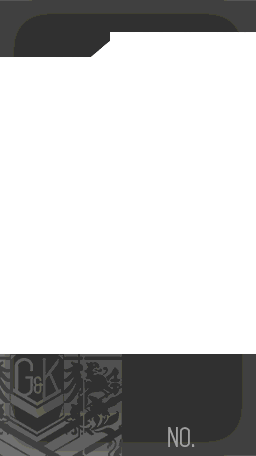Ranking of this Doll's specs relative to other Dolls of the same type.
P7: Difference between revisions
No edit summary |
No edit summary |
||
| (54 intermediate revisions by 18 users not shown) | |||
| Line 1: | Line 1: | ||
{{ | {{PlayableUnit | ||
|index = 100 | |index = 100 | ||
|nationality = | |nationality = West Germany | ||
|classification = | |classification = HG | ||
|rarity = 4 | |rarity = 4 | ||
|faction = [[Griffin & Kryuger]] | |||
|manufactureringame = [[I.O.P.]] | |||
|manufacturer = Heckler & Koch | |manufacturer = Heckler & Koch | ||
|artist = | |artist = {{artist name|Saru}} | ||
|fullname = Heckler & Koch P7 | |fullname = Heckler & Koch P7 | ||
|voiceactor = Kurosawa Tomoyo | |voiceactor = {{voice actor name|Kurosawa Tomoyo}} | ||
|min_dmg= | |releasedon = {{doll_server_alias|server=CN|alias=P7|year=2016|month=5}}, {{doll_server_alias|server=TW|alias=P7}}, {{doll_server_alias|server=KR|alias=P7}}, {{doll_server_alias|server=EN|alias=P7}}, {{doll_server_alias|server=JP|alias=P7}} | ||
|weaponinfo = | |||
The Heckler & Koch P7 is a German 9×19mm semi-automatic pistol designed by Helmut Weldle and produced from 1979 to 2008 by Heckler & Koch GmbH (H&K). It was revealed to the public for the first time in 1976 as the PSP (Polizei-Selbstlade-Pistole—"police self-loading pistol"). While praised for its accuracy and reliability, the P7's high price tag prevented many police agencies from adopting the handgun.<ref name = "P7 wiki">[[wikipedia:Heckler & Koch P7|Wikipedia entry on P7]]</ref> | |||
Prompted by the 1972 Munich Olympics Massacre, the West German police decided to replace their .32 ACP Walther PP handguns with a similarly-sized pistol chambered for the more powerful 9x19mm Parabellum cartridge. The German police put forth a list of requirements for the new handgun: the gun could weigh no more than 1,000 g (35 oz); the pistol's dimensions could not exceed 180 × 130 × 34 mm; the gun needed to have a muzzle energy of no less than 500 J; and the pistol needed to able to achieve a service life of at least 10,000 rounds. The pistol was also to be fully ambidextrous, safe to carry with a loaded chamber (both holstered and concealed in a pocket), and able to be quickly drawn and instantly ready to fire. A number of designs were submitted, and in the end the German police actually decided to adopt three designs: the Walther P5, the SIG P225 (designated the P6), and the HK P7. Police agencies could then decide for themselves on which one of the three pistols their officers would be given, based on available funding and manpower. | |||
The P7 is a semi-automatic blowback-operated firearm. However, unlike other pistols that used recoil or simple blow-back mechanisms, the operation of the P7 actually relies a gas delayed blow-back system. This mechanism was modeled on the one used in the Swiss Pistole 47 W+F (Waffenfabrik Bern) prototype pistol, as well as the Barnitzke system first used in the Volkssturmgewehr 1-5. The system works be taking gas pressure from the ignited cartridge and feeding it through a small port in the barrel in front of the chamber, in order to slow the rearward motion of the slide. This is accomplished by means of a piston contained inside a cylinder located under the barrel that opposes the rearward motion of the slide until the gas pressure has declined — after the bullet has left the barrel — hence allowing the slide to end its rearward motion, opening the breech and ejecting the empty cartridge case. The advantages of this system include a simpler manufacturing process and a high mechanical accuracy (due to the barrel being fixed in the frame). The P7 features a hexagonal rifling pattern to achieve a longer service life time. The P7 was primarily designed for the 9mm Parabellum cartridge, and the original PSP model feeds 8 rounds from its single-stack magazine.<ref name = "P7 Forgotten Weapons">[https://www.youtube.com/watch?v=zq7_w6FWenY Forgotten Weapons video on the P7 pistol series]</ref> | |||
The most defining mechanical feature of the P7 series is the unique built-in cocking lever located at the front of the grip. This cocking lever acts as a safety, as before the pistol can be fired, this lever must be squeezed. Squeezing the cocking lever with a force of 70 N (15.7 lb) cocks the firing pin. Once fully depressed, only 2 pounds of force is required to keep the weapon cocked. The weapon is then fired by pressing the single stage trigger rated at approximately 20 N (4.5 lb). As long as the lever is depressed, the weapon fires like any other semi-automatic pistol. If the lever is released, the weapon is immediately de-cocked and rendered safe. This method of operation dispensed the need for a manual safety selector while providing safety for the user carrying the pistol with a chambered round, and increased the speed with which the pistol could be deployed and fired. | |||
Series production of the P7 started in 1979. Shortly after, the pistol was adopted by the German Federal Police's counter-terrorism unit, GSG 9, as well as the German Army's special forces formations. The P7 and its variants were also widely exported to many countries, where they are used primarily by law enforcement units, special police, and counter terrorist units. Between 1982 and 1983, the P7 received several modifications aimed at addressing American market demands and shooter preferences. These modifications resulted in the P7M8 model, which featured a new magazine release lever (available on both sides of the frame) installed just beneath the trigger guard. This change forced HK designers to modify both the pistol's frame and magazine. In addition, the trigger guard was equipped with a synthetic heat shield that protected the shooter from excessive heating. The firing pin and its bushing were also changed. A version of the P7, the P7M13, was entered to the US Army XM9 pistol trials as a potential replacement for the aging M1911 pistol. The main difference between the P7 and P7M13 was the P7M13's use of double-stack magazines, which enabled the P7M13 to achieve a 13-round capacity. Ultimately, the P7M13 lost the pistol trials to the Beretta M9. | |||
The P7 was "very well received" by the German Police, who complained when it was removed from service in the 2000s. While the P7 was lightweight, reliable, and accurate, it lost many sales in both military and police units to cheaper offerings by other companies such as Beretta, Glock, SIG, and Smith & Wesson. Versions of the P7 would remain in production until 2008. | |||
|design = | |||
A T-Doll with animal features, P7 sports cat ears and a tail. Her outfit resembles a nun... Cat-nun? P7's primary color scheme is white, purple, and pink, with these colors being present in most of her outfit as well as her long white hair and purple eyes. In her official art, a lot of cross symbols can be found: as decoration ornaments, as clothes patterns, and as her iris shape. As revealed by the Girls' Frontline manga series, P7's body height is around 120 cm, making her a fairly small T-Doll physically. | |||
|min_dmg= 12 | |||
|max_dmg= 32 | |max_dmg= 32 | ||
|min_eva= 11 | |min_eva= 11 | ||
| Line 14: | Line 34: | ||
|min_acc= 8 | |min_acc= 8 | ||
|max_acc= 62 | |max_acc= 62 | ||
|min_rof= | |min_rof= 42 | ||
|max_rof= | |max_rof= 61 | ||
|min_hp= 32 | |min_hp= 32 | ||
|max_hp= 63 | |max_hp= 63 | ||
|mov= 15 | |mov= 15 | ||
|craft= 0:55:00 | |craft= 0:55:00 | ||
|noheavycraft=1 | |||
|drop= Chapter 5-E (All Maps), 6-3, 6-2E, 7-4, 8-5, 8-2E, 9-5, 10-1, 11-5, 11-1E | |||
|aura1= Affects all guns | |aura1= Affects all guns | ||
|aura2= Increases evasion by {{HG aura|24}} | |aura2= Increases evasion by {{HG aura|24}} | ||
| Line 26: | Line 50: | ||
|tile2= 1 | |tile2= 1 | ||
|tile3= 1 | |tile3= 1 | ||
|tile7= 1 | |tile7= 1 | ||
|tile8= 1 | |tile8= 1 | ||
|tile9= 1 | |tile9= 1 | ||
|tile5 = 0 | |tile5= 0 | ||
|costume1= Pinky Swear | |||
|costume2= Sister Gunslinger | |||
|costume3= costume3 | |||
| | |||
| | |||
| | |||
|gallery=<gallery> | |||
File:P7_S.png|Profile image | |||
File:P7.png|Full artwork | |||
File:P7_D.png|Full damaged artwork | |||
File:P7_costume1.png|"Pinky Swear" artwork | |||
File:P7_costume1_D.png|"Pinky Swear" damaged artwork | |||
File:P7_costume2.png|"Sister Gunslinger" artwork | |||
File:P7_costume2_D.png|"Sister Gunslinger" damaged artwork | |||
File:P7_costume3.png| | |||
File:P7_costume3_D.png| | |||
</gallery> | |||
|galleryAlt=<gallery> | |||
| | File:P7_avg.png|Story artwork. | ||
File:P7_costume1_D (Censored 1).png|"Pinky Swear" damaged artwork (EN Censorship) | |||
File:Invitation from the Full Moon Login Wallpaper.png|"Invitation from the Full Moon" Login wallpaper illustrated by 水乌龟 (Suisai) | |||
</gallery> | |||
}} | |||
[[Category:T-Dolls with censoring]] | |||
Latest revision as of 11:00, 17 August 2024
| P7 | Story | Quotes |
P7 100   | |
| Gun Information | |
|---|---|
| Full name | Heckler & Koch P7 |
| Country of origin | West Germany |
| Manufacturer | Heckler & Koch |
| Game Information | |
| Faction | Griffin & Kryuger |
| Manufactured / Revised by |
I.O.P. |
| Voice actor | Kurosawa Tomoyo |
| Artist | Saru |
| Released on | CN (2016-5), TW, KR, EN, JP |
| Chibi Animation | |
| Variant:
Click the marked area to switch between animations. For details regarding animations, please see Animations on the Wiki. | |
| View page template | |
How to obtain[edit]
NORMALHEAVY Timer 0:55:00. See T-Doll Production for details.
DROP Chapter 5-E (All Maps), 6-3, 6-2E, 7-4, 8-5, 8-2E, 9-5, 10-1, 11-5, 11-1E
REWARD Not obtained as a reward
Exclusive Equipment[edit]
Union Skill[edit]
There is no union skill for this T-Doll.
Stats / Data[edit]
| 32(x1) → 63(x1) / 315(x5) | 10(x1) / 30(x5) | 10(x1) / 30(x5) |
|
| ||||||||
|
| ||||||||
| 15 | 0 | ||||||||
| 20% | 50% | ||||||||
| 15 |
Ranking of this Doll's specs relative to every other Doll.
Weapon Background[edit]
The Heckler & Koch P7 is a German 9×19mm semi-automatic pistol designed by Helmut Weldle and produced from 1979 to 2008 by Heckler & Koch GmbH (H&K). It was revealed to the public for the first time in 1976 as the PSP (Polizei-Selbstlade-Pistole—"police self-loading pistol"). While praised for its accuracy and reliability, the P7's high price tag prevented many police agencies from adopting the handgun.[1]
Prompted by the 1972 Munich Olympics Massacre, the West German police decided to replace their .32 ACP Walther PP handguns with a similarly-sized pistol chambered for the more powerful 9x19mm Parabellum cartridge. The German police put forth a list of requirements for the new handgun: the gun could weigh no more than 1,000 g (35 oz); the pistol's dimensions could not exceed 180 × 130 × 34 mm; the gun needed to have a muzzle energy of no less than 500 J; and the pistol needed to able to achieve a service life of at least 10,000 rounds. The pistol was also to be fully ambidextrous, safe to carry with a loaded chamber (both holstered and concealed in a pocket), and able to be quickly drawn and instantly ready to fire. A number of designs were submitted, and in the end the German police actually decided to adopt three designs: the Walther P5, the SIG P225 (designated the P6), and the HK P7. Police agencies could then decide for themselves on which one of the three pistols their officers would be given, based on available funding and manpower.
The P7 is a semi-automatic blowback-operated firearm. However, unlike other pistols that used recoil or simple blow-back mechanisms, the operation of the P7 actually relies a gas delayed blow-back system. This mechanism was modeled on the one used in the Swiss Pistole 47 W+F (Waffenfabrik Bern) prototype pistol, as well as the Barnitzke system first used in the Volkssturmgewehr 1-5. The system works be taking gas pressure from the ignited cartridge and feeding it through a small port in the barrel in front of the chamber, in order to slow the rearward motion of the slide. This is accomplished by means of a piston contained inside a cylinder located under the barrel that opposes the rearward motion of the slide until the gas pressure has declined — after the bullet has left the barrel — hence allowing the slide to end its rearward motion, opening the breech and ejecting the empty cartridge case. The advantages of this system include a simpler manufacturing process and a high mechanical accuracy (due to the barrel being fixed in the frame). The P7 features a hexagonal rifling pattern to achieve a longer service life time. The P7 was primarily designed for the 9mm Parabellum cartridge, and the original PSP model feeds 8 rounds from its single-stack magazine.[2]
The most defining mechanical feature of the P7 series is the unique built-in cocking lever located at the front of the grip. This cocking lever acts as a safety, as before the pistol can be fired, this lever must be squeezed. Squeezing the cocking lever with a force of 70 N (15.7 lb) cocks the firing pin. Once fully depressed, only 2 pounds of force is required to keep the weapon cocked. The weapon is then fired by pressing the single stage trigger rated at approximately 20 N (4.5 lb). As long as the lever is depressed, the weapon fires like any other semi-automatic pistol. If the lever is released, the weapon is immediately de-cocked and rendered safe. This method of operation dispensed the need for a manual safety selector while providing safety for the user carrying the pistol with a chambered round, and increased the speed with which the pistol could be deployed and fired.
Series production of the P7 started in 1979. Shortly after, the pistol was adopted by the German Federal Police's counter-terrorism unit, GSG 9, as well as the German Army's special forces formations. The P7 and its variants were also widely exported to many countries, where they are used primarily by law enforcement units, special police, and counter terrorist units. Between 1982 and 1983, the P7 received several modifications aimed at addressing American market demands and shooter preferences. These modifications resulted in the P7M8 model, which featured a new magazine release lever (available on both sides of the frame) installed just beneath the trigger guard. This change forced HK designers to modify both the pistol's frame and magazine. In addition, the trigger guard was equipped with a synthetic heat shield that protected the shooter from excessive heating. The firing pin and its bushing were also changed. A version of the P7, the P7M13, was entered to the US Army XM9 pistol trials as a potential replacement for the aging M1911 pistol. The main difference between the P7 and P7M13 was the P7M13's use of double-stack magazines, which enabled the P7M13 to achieve a 13-round capacity. Ultimately, the P7M13 lost the pistol trials to the Beretta M9.
The P7 was "very well received" by the German Police, who complained when it was removed from service in the 2000s. While the P7 was lightweight, reliable, and accurate, it lost many sales in both military and police units to cheaper offerings by other companies such as Beretta, Glock, SIG, and Smith & Wesson. Versions of the P7 would remain in production until 2008.
Character Design
A T-Doll with animal features, P7 sports cat ears and a tail. Her outfit resembles a nun... Cat-nun? P7's primary color scheme is white, purple, and pink, with these colors being present in most of her outfit as well as her long white hair and purple eyes. In her official art, a lot of cross symbols can be found: as decoration ornaments, as clothes patterns, and as her iris shape. As revealed by the Girls' Frontline manga series, P7's body height is around 120 cm, making her a fairly small T-Doll physically.
Gallery
Main artwork
Gallery consisting of artworks used primarily in-game. For information on how to obtain certain costumes, see Skin Catalogue.
-
Profile image
-
Full artwork
-
Full damaged artwork
-
"Pinky Swear" artwork
-
"Pinky Swear" damaged artwork
-
"Sister Gunslinger" artwork
-
"Sister Gunslinger" damaged artwork
Alternative artwork
Alternate gallery consisting of artworks with slight alterations as well as miscellaneous artworks.
-
Story artwork.
-
"Pinky Swear" damaged artwork (EN Censorship)
-
"Invitation from the Full Moon" Login wallpaper illustrated by 水乌龟 (Suisai)
References[edit]
| List of T-Dolls |
|---|


























